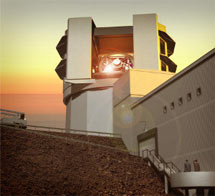

Tuesday - October 19, 2010
SLAC Today is
available online at:
http://today.slac.stanford.edu
In this issue:
Webb Honored with Lytle Award
In the News: Astronomical Computing
 |
 |
|
Tuesday - October 19, 2010 |
Webb Honored with Lytle AwardFarrel Lytle (left) congratulates Sam Webb, this year's recipient of the Farrel W. Lytle Award. (Photo by Kelen Tuttle.)
Congratulations to Stanford Synchrotron Radiation Lightsource Staff Scientist Sam Webb, this year's recipient of the 2010 Farrel W. Lytle Award. Given annually since 1998, the award recognizes technical or scientific achievements in synchrotron radiation-based science as well as efforts to promote collaboration and efficiency at SSRL. "I was completely—but pleasantly—shocked," Webb said yesterday after the announcement was made at the 2010 SSRL and Linac Coherent Light Source Users' Conference. "Being in the X-ray absorption business, we all use the Lytle detector. I've had the further pleasure of helping Farrel out with his data collection here at SSRL. But to win this award… all I can say is that I'm very happy and very, very humbled." SSRL Users Organization Executive Committee Member Wayne Lukens, who presented the award, said that Webb received the honor for his exceptional skills and motivation, dedication to technical and software developments, remarkable commitment to the user community, positive attitude and generous personality. In all, Lukens said, Webb helps users to achieve the most satisfying and productive scientific experience at SSRL's micro-imaging spectroscopy beamlines. "Sam's dedication to synchrotron science and SSRL users makes him unique and a great asset to SSRL," said Sarah Hayes, a researcher from the University of Arizona and an SSRL user. "His scientific savvy, investment in user projects and technical expertise… foster efficient use of beam time and have brought many collaborations to SSRL. For me, Sam embodies everything I expect from SSRL: a commitment to scientific excellence, consistently working for technical improvements that enhance science, and a desire to go the extra mile to make sure users are collecting the best data in the most efficient way." Congratulations, Sam! In the News: Astronomical Computing A visualization of the LSST. (Image: Todd Mason, Mason Productions Inc./LSST Corporation.)
The Large Synoptic Survey Telescope to be constructed in Chile will incorporate the world's largest digital camera, capable of recording highly detailed data more quickly than any other telescope of comparable resolution. For the scientists working on the project, that all amounts to an exciting opportunity to learn more about moving objects (including monitoring asteroids near the Earth), transients such as the brief conflagrations of supernovae, dark energy and the structure of the galaxy. For computing specialists, it means more data. A lot more data. Read more in International Science Grid This Week. |
Events
Access (see all)Announcements
|
|
| | ||
|
|
||
 <%
Response.AddHeader "Last-modified", getArticleDate()
'Response.AddHeader "Last-modified","Mon, 01 Sep 1997 01:03:33 GMT"
'Monday, December 06, 2010
%>
<%
Response.AddHeader "Last-modified", getArticleDate()
'Response.AddHeader "Last-modified","Mon, 01 Sep 1997 01:03:33 GMT"
'Monday, December 06, 2010
%>View online at http://today.slac.stanford.edu/. |
||